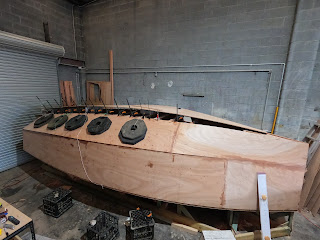So, around December 2022, I moved from the Ocean Crusaders yard location in Hemmant to Multihull Marine in Ransome. I'll forever be grateful to Annika and Thommo who provided me with shed space to be able to kickstart my dream of building a Globe 5.80 sailboat. Their support and initial encouragement were a catalyst that helped me to believe I could achieve this goal and commit to it. The shed space in Hemmant was also fantastical in all aspects; it was indoor and dry, with a fantastic community of people who were often around to help me out. Annika and Thommo completed the rebuild of their TP52 J-Bird project and had to move out / downsize from that shed space. It was time to find a new location and move my boat there.
It took me a few weeks to find out a new location. I made several enquiries around for available shed space. However, all places were commercial worksheds with sky-high rents that were absolutely out of budget. My friend Christine finally told me about Multihull Marine Boat Yard, which is luckily only a 10-minute drive from my house. I drove to the yard one day to check it out and see if they had any available space. I was pleasantly surprised by how neat the boatyard was and went into the office to talk to someone. I met Damien, who manages the place, and he was probably equally surprised to have a woman ask about bringing her boat there. Luckily, he had a few outdoor spaces available, which he showed me, and the rent was reasonable, too. I picked the spot he said is least likely to flood; fingers crossed.
Next I needed to arrange transportation of my boat to the new location. I estimated the drive would take a maximum of 30 minutes plus the loading and offloading time, so it did not seem like something that would be difficult to organise. I contacted several companies to hire a flatbed truck with a crane and to my surprise, only one eventually reluctantly and quite rudely told me there's no chance he'll do the job. I called the guy to figure out what the issue was, and he told me that because it was a timber boat, it was basically too risky to move. So, in a way, it's an insurance problem. I thanked the man for his feedback so I at least understood what the issue was. I considered a few more creative transportation ideas, including hiring a truck and getting a friend with a truck license to drive it or the option of hiring one of those U-haul car transport trailers. Those were dead ends. I was running out of time, and then my husband had a brilliant idea. One Friday night, he said, "Why don't you put the job on Airtasker?" Pff, not sure if boat transport is the usual thing people put on Airtasker, but I thought, eh, what the hell, let's do it. In less than an hour, I exchanged a few messages with some bloke with a truck who was willing to do the job the following morning for a perfectly reasonable price.
So one fine Saturday morning, me and my friend, who supposedly had some experience with trucks, went down to the boatyard to get everything ready for transportation. Some 20-something, rather young-looking bloke turned up with a truck. I would think he was barely qualified to drive a car without learner plates. But, he was there, polite and professional, with (clearly) his boss' truck and unphased by my nervousness about the risks of transporting my precious baby. My friend and I took the responsibility of loading the boat up in our hands. We secured her with strong ratchet straps, blocked the cradle wheels and away we went. I instructed the young man to drive so carefully as if he were transporting a million-dollar cargo, and I followed him in my car. The 20-minute slow drive to the new boatyard went without any troubles apart from me sweating and nearly having a heart attack at every turn. At the new yard, all the stress rolled off my chest, and the truck driver offloaded my boat with a crane and a big smile on his face. Everything was well, the boat was at the new yard, secured with a tarp to keep her dry. A few days later I returned and constructed an A-frame out of scrap timber from the strongback. Once the tarp was stretched over the frame I was able to resume working on the boat.













































